Aisle containment offers efficient cooling of IT hardware but could interfere with fire protection
Despite the rise of cloud architecture, many larger businesses still maintain on-site server rooms or data centers. And cloud providers, of course, run massive data centers. As mission-critical infrastructure, server rooms and data centers need redundant protection to meet users’ 24/7 needs. This protection includes properly cooling this machinery and ensuring adequate fire protection—two priorities that can sometimes come into conflict.
Computing is pretty hot work, and IT personnel work hard to keep their servers cool. Data centers use about 2% of the world’s electricity, and a large portion of that is spent on cooling. Aisle containment systems efficiently manage heat in large server operations by keeping hot and cold air from mixing. Server racks are arranged in rows, and the spaces between them (the aisles) are isolated from their surroundings.
This containment increases energy efficiency and “allows uniform IT inlet temperatures and eliminates hot spots typically found in traditional uncontained data centers.”
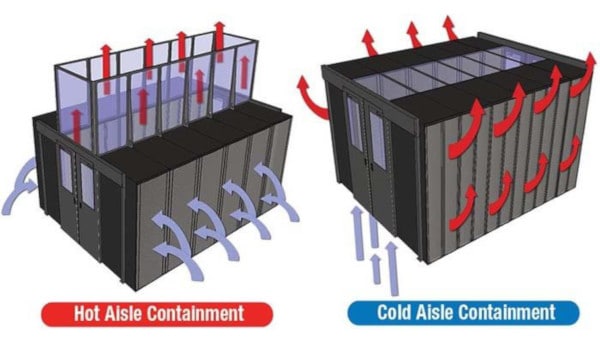
In all aisle-containment systems, a computer room air handler (CRAH) circulates chilled air through the aisles. These systems can be arranged in the following three ways:
- “Cold-aisle” containment, where cold air is introduced to the contained aisle and exits via the server racks to the surroundings.
- “Hot-aisle” containment, where cold air is introduced to the surroundings and flows through server racks to the contained aisle.
- “Hot-aisle/cold-aisle (HACA)” containment, where cold air is pumped into dedicated cold aisles (often through a subfloor), through the server racks, and into dedicated hot aisles, and then back to the CRAH to be rechilled.
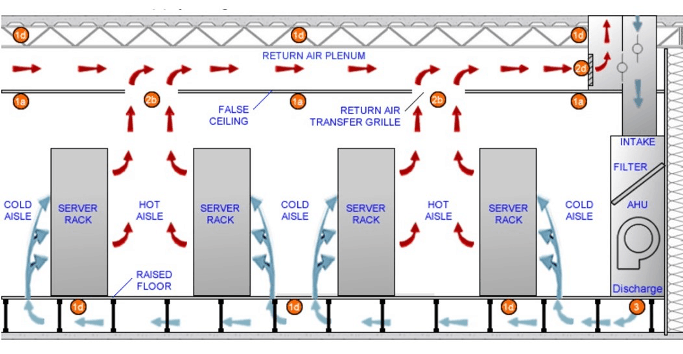
Aisle containment is often an after-market modification to server rooms, and it effectively increases energy efficiency and manages the temperature of this hot-running machinery. But it could mess up your fire protection infrastructure unless you take proper precautions. Aisle containment requires barriers and rapid airflow and creates localized high temperatures, three things that can keep a fire detection and suppression system from functioning properly.
The National Fire Protection Association (NFPA) writes model fire codes and standards that govern the application, installation, and maintenance of fire protection systems. NFPA 75: Standard for the Fire Protection of Information Technology Equipment (2013 edition) recommends that facilities with aisle containment check the efficacy of their fire protection infrastructure:
5.6.7 Where aisle containment systems are installed, the existing suppression and detection systems shall be evaluated, modified, and tested as necessary to maintain compliance with the applicable codes and standards.
If you have or are interested in aisle containment, it’s essential to assess how it may interact with fire protection systems. There are four main ways this could happen:
- The barriers could obstruct fire suppression systems.
- The high airflow could impede smoke detection.
- The high airflow could prevent clean agent suppression systems from achieving necessary gas concentrations.
- The temperatures in hot aisles could be too high for your protection equipment to function correctly.
Is aisle containment obstructing your sprinklers or clean agent server room fire protection systems?
Automatic fire suppression is the first line of defense against a fire. And a server room should be protected by sprinklers or clean agent systems.
Water damage can be costly, especially in settings like server rooms. Many server rooms with water-based fire suppression systems use preaction systems to prevent accidental water discharge.
Preaction systems prevent accidental discharge of water by using at least two checkpoints: a preaction valve controlled by some type of separate detection system and a heat-sensitive element (either a glass bulb filled with liquid or a metal link—both found in typical fire sprinklers). Water cannot be discharged until 1) the preaction valve opens and 2) the heat-sensitive element activates.
Most systems come in “single-interlock” and “double-interlock” varieties, and both reduce the chances of accidental water discharge.
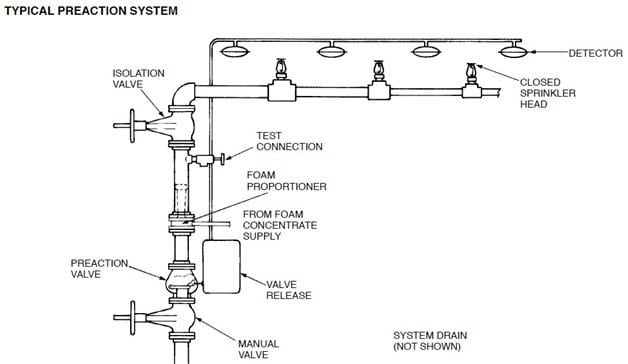
Instead of (or in addition to, depending on local requirements) a preaction water sprinkler system, a server room might have a clean agent suppression system. Clean agent systems release inert gases (e.g., CO2 or argon), halocarbons (e.g., Novec 1230 or FM-200), or other agents to fight fires through heat absorption or oxygen deprivation. These discharges require no clean-up and do not harm computer equipment, making them ideal for server rooms.
NFPA 75 requires each containment area to have its own sprinklers or gaseous suppression. Note that HACA cooling systems are often added to existing server rooms after the fire protection mechanism is in place. Server rooms retrofitted for aisle containment often use panels installed between the tops of IT cabinets and the ceiling to separate the aisles.
Sprinklers or gaseous suppression systems must protect each aisle, and, in the former case, sprinklers must be able to produce a proper spray pattern. Section 5.6.8 of NFPA 75 requires modification of sprinkler systems to provide adequate coverage when aisle containment creates obstructions. The most straightforward way to do this is to understand that each aisle is a separate “room” and protect it accordingly.
However, section 5.6.10.1 of NFPA 75 says that modifications of clean agent systems are not needed if obstructions can be automatically removed without blocking egress routes and compromising protection levels.
Some individuals have proposed using heat-sensitive drop-away panels to remove barriers and clear the area for sprinklers. But this is a poor solution because:
- Falling panels may block exit routes.
- Thermally activated panels require fires to grow before they work. Even small fires can be extremely destructive in server rooms.
- Server room suppression systems could activate before the panels fall away. Clean agent systems are typically triggered by smoke that can be detected before a thermal signal.
Moreover, NFPA 75 does not allow for panels to be used this way. Section 5.6.10.1(1) specifies that the removal of obstructions must be controlled by smoke detection rather than heat sensitivity. Section 5.6.10.1(5) requires that all obstacles be automatically removed in the suppression area simultaneously. This is not possible with heat-sensitive panels.
Mechanical barrier removal is a better option. The removal of all barriers in a suppression zone can be initiated by a smoke detector signal and does not require panels to fall to the ground. Belden, for instance, sells aisle containment with electrically-activated tilting panels.
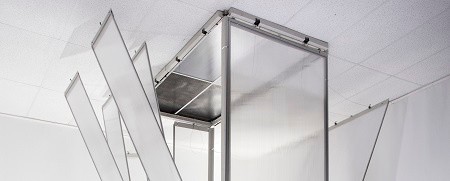
Detection and aisle containment—will your smoke detectors work?
Fire suppression systems in server rooms often depend on smoke detectors. Both preaction sprinklers and clean agent systems require electronic input from a sensor, and that sensor is often a smoke detector. Aisle containment is basically guaranteed to challenge this equipment, however. If you plan to retrofit a server room with aisle containment, make sure the smoke detectors still function correctly.
Even small fires can cause costly damage in server rooms, so it is crucial to catch them before they grow. Detectors in a server room without aisle containment already have to pick up on faint signals. Aisle containment introduces air turbulence, directional airflow, and high air velocity (between 500 and 1000 air changes per hour, or ACH, in HACA environments). Small smoke plumes can be quickly diluted and swept away from detectors in these environments.
Only a professional can tell you precisely what smoke detector set-up would work for your facility. However, a system can detect smoke more easily if you recirculate 100% of your air. Whatever the case, adaptations in light of HACA containment will probably involve some combination of the following:
- Using highly sensitive detectors.
- Decreasing the space between detectors.
- Mounting detectors on the ceiling or in the ceiling plenum.
- Using air-sampling smoke detectors (ASSD).
You need sensitive smoke detectors to protect sensitive equipment. This is doubly true in the challenging environment of aisle containment. Assuming the use of photoelectric sensors, this means employing detectors that are sensitive to very small amounts of obscuration by smoke.
NFPA 76: Standard for the Fire Protection of Telecommunications Facilities states that very-early warning fire detection (VEWFD) systems should give an alert at 0.2%/ft obscuration and give an alarm at 1%/ft obscuration. FAAST has detectors designed for HACA environments that are sensitive to 0.00046%/ft obscuration. Consult with a professional to determine how sensitive your detectors need to be.
The coverage provided by point detectors decreases as ACH increases. NFPA 72®: National Fire Alarm and Signaling Code® (2019 edition) provides guidelines for detectors’ spacing in high airflow environments via Table 17.7.6.3.3.2. However, no guidance is given above 60 ACH (at which point a detector is needed for every 125 ft2); it stands to reason that more detectors are proportionally required in environments with aisle containment. These devices may need to be spaced 10 ft or less from one another to achieve proper coverage.
Aspirating smoke detectors (ASD), also called air-sampling smoke detectors (ASSD), can be good choices for aisle containment. ASSD is active (rather than passive) smoke detection—air is drawn through a series of sampling pipes to a detector. While ASSD cannot tell you exactly where smoke is coming from, it uses representative samples of a room’s air to detect it.
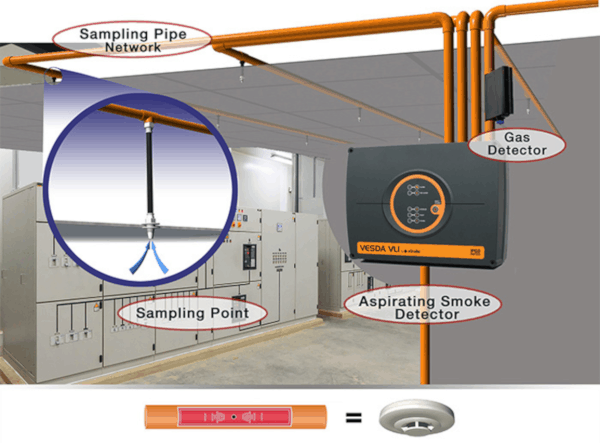
Placement of the devices is also crucial in aisle containment environments. Detectors located in the CRAH were mostly ineffective in one study by the Fire Research Foundation. The same research found that detectors mounted on the ceiling or in the ceiling plenum are effective, and Belden echoes this opinion.
If you installed a subfloor with your aisle containment, you might need to place smoke detectors in it, especially if the room contains cables. However, the Fire Research Foundation study says that subfloor detectors may be ineffective as detectors for the whole system without air recirculation.
Aisle containment and clean agent concentration
Many server rooms use clean agent fire suppression systems in place of (or in addition to) sprinklers. While single and double-interlock preaction systems require multiple conditions to be met before discharge occurs, water still causes costly damage. For this reason, many companies opt for clean agent suppression systems.
The gases emitted by these set-ups achieve a target concentration in a room for a period to extinguish a fire. But the constant and rapid air circulation in aisle containment systems can impede clean agent systems’ ability to achieve a necessary concentration.
The 2013 edition of NFPA 75 (section 5.6.10) says that modifications are required if an aisle containment system prevents a gaseous suppression system from delivering the necessary amount of gas to the entire protected area.
You should not try to evaluate your system on your own. Consult with a professional to determine if your clean agent suppression system works or will work with retrofitted aisle containment. But in all cases, ventilation systems should be automatically shut down before gas discharge in all clean agent systems, not just where aisle containment is in use. Stopping the ventilation before agent discharge eliminates the problems associated with aisle containment.
This video from BBC Fire and Security shows fire protection systems integrated properly with aisle containment. Aspirating smoke detectors effectively detect smoke in the high-airflow environment and ventilation is shut off before clean agent gas is released:
Hot aisle temperatures—can your server room fire protection equipment stand the heat?
Aisle containment (particularly hot-aisle and HACA systems) concentrates hot air by design. The temperature in a hot aisle can get as high as 117 °F—an extreme environment. NFPA 75 says:
5.5.6 Detection and suppression components within aisle containment systems shall be rated for the intended temperature of hot aisles when installed in those locations.
Take care that heat-activated sprinkler heads are sensitive to the right temperature, that smoke detectors work properly in high temperatures, and that clean agent systems can achieve the required gas concentrations at high temperatures.
Heat-sensitive sprinklers in the hot aisle
Table 7.2.4.1 in NFPA 13 (2019 edition) classifies the heat-sensitive bulbs or metal links in sprinkler heads based on their activation and maximum ceiling temperatures. An “ordinary” sprinkler head has a maximum ceiling temperature of 100 °F and activates between 135 and 170 °F. Ordinary sprinklers are not rated for the extreme temperatures of hot aisles. Section 9.4.2.2 requires that sprinklers rated for higher heat be used when ceiling temperature exceeds 100 °F.
“Intermediate” sprinklers may do the job. They are rated for maximum ceiling temperatures of 150 °F and activate between 175 and 225 °F—well outside normal temperature ranges in hot aisles.

Smoke detectors and high temperatures
Extreme temperatures can impact the effectiveness of smoke detectors. Where temperatures are expected to be colder than 32 °F or hotter than 100 °F, NFPA 72 requires smoke detectors to be specifically rated for the conditions. Because hot aisles routinely have temperatures above this range, rated detectors are needed.
Clean agent gas concentration in high heat
As mentioned, clean agent gases need to achieve specific concentrations and pressures in the hazard area to suppress a fire. The specific volume (volume produced from a given weight) of a gas increases as temperature increases. NFPA 2001 (2018 edition) lists the required amount (in pounds per cubic feet in the hazard area) of different clean agents for different temperatures and specific volumes. The good news is that amount of clean agent needed decreases as temperature increases. A clean agent suppression system in an after-market hot aisle probably won’t have insufficient gas.
The bad news is that the pressure could become dangerously high in the hazard zone if too much clean agent is discharged relative to the temperature. Rooms protected by clean agent systems are often equipped with pressure relief vents to protect the building’s structural integrity from the sudden increase in inside air pressure.
Consult a professional to ensure that your aisle containment system’s high temperatures don’t create a hazard when the clean agent system activates.
Don’t skimp on fire protection in your server room
If you use aisle containment to cool your servers, you are serious about IT. So, don’t get sloppy when it comes to fire protection. A server room may have been adequately protected before, but retrofitted aisle containment changes everything. It creates new spaces and barriers and radically changes the airflow.
This article’s information is designed to highlight common problems and solutions, but it is far from exhaustive. Consult with professionals to make sure your fire protection and suppression systems work properly.
You don’t want to worry about damaging your computer equipment with a fire extinguisher. Save lives and data at the same time. Outfit yourself with CO2 fire extinguishers from QRFS. We also carry cabinets, covers, and other accessories for extinguishers. If you don’t find what you need on our website, contact us, and we’ll help you get it.



My children are building a prototype and I am looking to buy thermal sensitive bulbs and fusible links. I am looking for the smallest ones possible. Any help would be appreciated.
Jessica — QRFS does not sell these components of sprinklers separately, if that is what you are after. The fusible link or bulb is manufactured as part of a sprinkler head and isn’t ever replaced (once a sprinkler goes off the entire head is replaced). If you are after the smallest (thinnest) bulb that’s part of a sprinkler, look for quick response models. Hope that helps and good luck on the project!